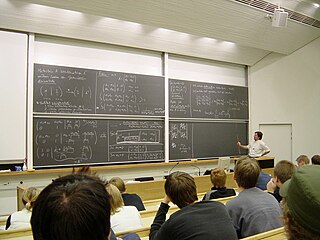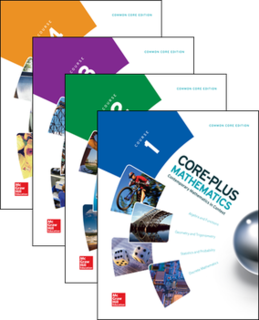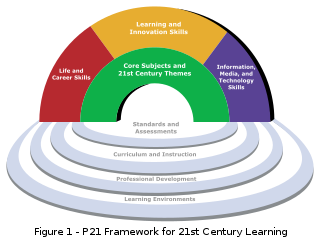Debate
Nearly every one of these distinctive characteristics has generated controversy and placed the IMP curriculum right in the middle of the “math wars,” the conflict between those that favor more traditional curricula in mathematics education and the supporters of the reform curricula that were largely an outgrowth of the 1989 NCTM standards.
IMP is among the reform curricula that have been heavily criticized by organizations such as Mathematically Correct. That organization's Internet site begins with a statement that “advocates of the new, fuzzy math” (focus) “on things like calculators, blocks, guesswork, and group activities and they shun things like algorithms and repeated practice. The new programs are shy on fundamentals and they also lack the mathematical depth and rigor that promotes greater achievement.” [7] Former NCTM president Frank Allen states, “Trying to organize school mathematics around problem solving instead of using its own internal structure for that purpose … (is destroying) essential connections….” [8]
Criticism often includes anecdotal evidence including stories of school districts that have decided to discontinue or supplement use of the IMP curriculum [9] and of students who did not feel they had been prepared adequately for college. [10] "Regular math is much better, it makes much more sense," says Aimee Lynn Stearns, a student at Taos High School in Taos, New Mexico.
On the other hand, some IMP students describe the program in positive terms. "It's fun, but it makes you really think," according to Ziouck Gonzalez, a student at Wells High School in Chicago, Illinois. Looking beyond student response, IMP was one of five mathematics education programs designated "exemplary" by the US Education Department in 1999, for "outstanding quality and demonstrated effectiveness." [11] It's About Time, the publisher of IMP, points out “the IMP first edition was published after more than 10 years of research, pilot testing, evaluating, field testing, revising, and detailed reviewing.” [12]
Supporters point to statistical studies that compare the performance of students enrolled in IMP courses with their peers enrolled in traditional high school mathematics courses. Merlino and Wolff, two such researchers, report that in their several studies IMP students consistently outperformed traditionally taught students on both the math and verbal sections of the PSAT, as well as on the SAT-9. [13] Kramer reported that grade 12 IMP students in his study performed better on all areas of mathematics tested by the NAEP test, [14] and Webb and Dowling reported IMP students performed significantly better on statistics questions from the Second International Mathematics Study, on mathematical reasoning and problem solving tasks designed by the State of Wisconsin, and on a quantitative reasoning test developed by a university to administer to entering students. [15] Taos High School began using the Interactive Math Program (IMP) in the 2006-07 school year. After three years of IMP classes, the initial cohort of 134 Taos High School juniors took the state mandated 11th grade Standards Based Assessment (SBA) in April, 2009. The SBA places students in one of four groups: Beginning Steps, Nearing Proficiency, Proficient and Advanced. The test results were compared with the SBA test scores of the previous two cohorts of juniors who had taken the SBA test after three years of traditional math instruction. The state test placed 53% of the 2009 IMP cohort in the proficient or advanced categories while the 2008 traditional math cohort’s proficiency rating was 43% and the 2007 cohort’s was 38%; roughly a combined 12% less than the IMP students (p < 0.025). The performance of the 2009 juniors was also analyzed over time. In 2006, the 2009 juniors were in 8th grade and 40% tested proficient or above in the 8th grade SBA. After three years of IMP, the percentage of these same students who now tested proficient or better had risen to 52% (p < .05). Students from the IMP cohort subsequently attended colleges and universities such as Stanford, Harvard, Carnegie Mellon, University of New Mexico and New Mexico State, among many others.

In contemporary education, mathematics education is the practice of teaching and learning mathematics, along with the associated scholarly research.
The Programme for International Student Assessment (PISA) is a worldwide study by the Organisation for Economic Co-operation and Development (OECD) in member and non-member nations intended to evaluate educational systems by measuring 15-year-old school pupils' scholastic performance on mathematics, science, and reading. It was first performed in 2000 and then repeated every three years. Its aim is to provide comparable data with a view to enabling countries to improve their education policies and outcomes. It measures problem solving and cognition.
Principles and Standards for School Mathematics (PSSM) are guidelines produced by the National Council of Teachers of Mathematics (NCTM) in 2000, setting forth recommendations for mathematics educators. They form a national vision for preschool through twelfth grade mathematics education in the US and Canada. It is the primary model for standards-based mathematics.
Founded in 1920, The National Council of Teachers of Mathematics (NCTM) is the world's largest mathematics education organization.
In elementary arithmetic, a standard algorithm or method is a specific method of computation which is conventionally taught for solving particular mathematical problems. These methods vary somewhat by nation and time, but generally include exchanging, regrouping, long division, and long multiplication using a standard notation, and standard formulas for average, area, and volume. Similar methods also exist for procedures such as square root and even more sophisticated functions, but have fallen out of the general mathematics curriculum in favor of calculators.
Saxon math, developed by John Saxon (1923–1996), is a teaching method for incremental learning of mathematics created in the 1980s. It involves teaching a new mathematical concept every day and constantly reviewing old concepts. Early editions were deprecated for providing very few opportunities to practice the new material before plunging into a review of all previous material. Newer editions typically split the day's work evenly between practicing the new material and reviewing old material. It uses a steady review of all previous material, with a focus on students who struggle with retaining the math they previously learned. However, it has sometimes been criticized for its heavy emphasis on rote rather than conceptual learning.

Core-Plus Mathematics is a high school mathematics program consisting of a four-year series of print and digital student textbooks and supporting materials for teachers, developed by the Core-Plus Mathematics Project (CPMP) at Western Michigan University, with funding from the National Science Foundation. Development of the program started in 1992. The first edition, entitled Contemporary Mathematics in Context: A Unified Approach, was completed in 1995. The third edition, entitled Core-Plus Mathematics: Contemporary Mathematics in Context, was published by McGraw-Hill Education in 2015.
Mathematically Correct was a U.S.-based website created by educators, parents, mathematicians, and scientists who were concerned about the direction of reform mathematics curricula based on NCTM standards. Created in 1997, it was a frequently cited website in the so-called Math wars, and was actively updated until 2003. The website went offline sometime in late 2012 or early 2013 but has been preserved on the Internet Archive.
Traditional mathematics was the predominant method of mathematics education in the United States in the early-to-mid 20th century. This contrasts with non-traditional approaches to math education. Traditional mathematics education has been challenged by several reform movements over the last several decades, notably new math, a now largely abandoned and discredited set of alternative methods, and most recently reform or standards-based mathematics based on NCTM standards, which is federally supported and has been widely adopted, but subject to ongoing criticism.
Investigations in Numbers, Data, and Space is a K–5 mathematics curriculum, developed at TERC in Cambridge, Massachusetts, United States. The curriculum is often referred to as Investigations or simply TERC. Patterned after the NCTM standards for mathematics, it is among the most widely used of the new reform mathematics curricula. As opposed to referring to textbooks and having teachers impose methods for solving arithmetic problems, the TERC program uses a constructivist approach that encourages students to develop their own understanding of mathematics. The curriculum underwent a major revision in 2005–2007.
Basic skills can be compared to higher order thinking skills. Facts and methods are highly valued under the back-to-basics approach to education.
MathLand was one of several elementary mathematics curricula that were designed around the 1989 NCTM standards. It was developed and published by Creative Publications and was initially adopted by the U.S. state of California and schools run by the US Department of Defense by the mid 1990s. Unlike curricula such as Investigations in Numbers, Data, and Space, by 2007 Mathland was no longer offered by the publisher, and has since been dropped by many early adopters. Its demise may have been, at least in part, a result of intense scrutiny by critics.
Integrated mathematics is the term used in the United States to describe the style of mathematics education which integrates many topics or strands of mathematics throughout each year of secondary school. Each math course in secondary school covers topics in algebra, geometry, trigonometry and analysis. Nearly all countries throughout the world, except the United States, follow this type of curriculum.
Math wars is the debate over modern mathematics education, textbooks and curricula in the United States that was triggered by the publication in 1989 of the Curriculum and Evaluation Standards for School Mathematics by the National Council of Teachers of Mathematics (NCTM) and subsequent development and widespread adoption of a new generation of mathematics curricula inspired by these standards.
Singapore math is a teaching method based on the national primary mathematics curriculum used for first through sixth grade in Singaporean schools. The term was coined in the United States to describe an approach originally developed in Singapore to teach students to learn and master fewer mathematical concepts at greater detail as well as having them learn these concepts using a three-step learning process: concrete, pictorial, and abstract. In the concrete step, students engage in hands-on learning experiences using physical objects which can be everyday items such as paper clips, toy blocks or math manipulates such as counting bears, link cubes and fraction discs. This is followed by drawing pictorial representations of mathematical concepts. Students then solve mathematical problems in an abstract way by using numbers and symbols.
Connected Mathematics is a comprehensive mathematics program intended for U.S. students in grades 6-8. The curriculum design, text materials for students, and supporting resources for teachers were created and have been progressively refined by the Connected Mathematics Project (CMP) at Michigan State University with advice and contributions from many mathematics teachers, curriculum developers, mathematicians, and mathematics education researchers.
Reform mathematics is an approach to mathematics education, particularly in North America. It is based on principles explained in 1989 by the National Council of Teachers of Mathematics (NCTM). The NCTM document, Curriculum and Evaluation Standards for School Mathematics, attempted to set forth a vision for K-12 mathematics education in the United States and Canada. Their recommendations were adopted by many education agencies, from local to federal levels through the 1990s. In 2000, NCTM revised its standards with the publication of Principles and Standards for School Mathematics (PSSM). Like the first publication, these updated standards have continued to serve as the basis for many states' mathematics standards, and for many federally funded textbook projects. The first standards gave a strong call for a de-emphasis on manual arithmetic in favor of students' discovering their own knowledge and conceptual thinking. The PSSM has taken a more balanced view, but still emphasizes conceptual thinking and problem solving.
From kindergarten through high school, the mathematics education in public schools in the United States has historically varied widely from state to state, and often even varies considerably within individual states. With the recent adoption of the Common Core Standards by 45 states, mathematics content across the country is moving into closer agreement for each grade level.
The Common Core State Standards Initiative is an educational initiative from 2010 that details what K–12 students throughout the United States should know in English language arts and mathematics at the conclusion of each school grade. The initiative is sponsored by the National Governors Association and Council of Chief State School Officers.

21st century skills comprise skills, abilities, and learning dispositions that have been identified as being required for success in 21st century society and workplaces by educators, business leaders, academics, and governmental agencies. This is part of a growing international movement focusing on the skills required for students to master in preparation for success in a rapidly changing, digital society. Many of these skills are also associated with deeper learning, which is based on mastering skills such as analytic reasoning, complex problem solving, and teamwork. These skills differ from traditional academic skills in that they are not primarily content knowledge-based.


